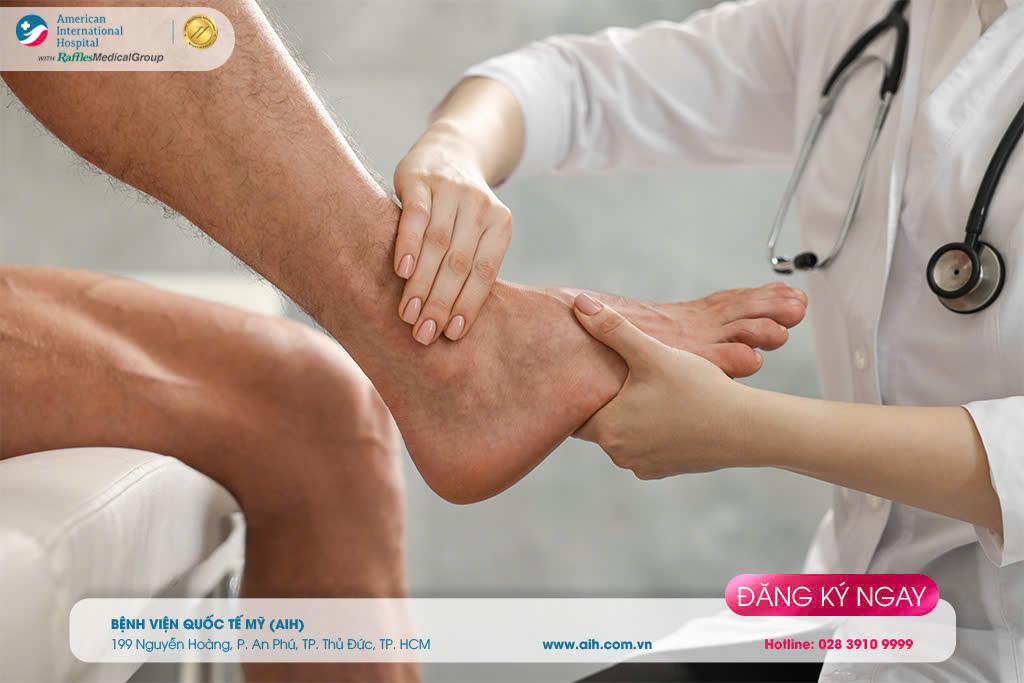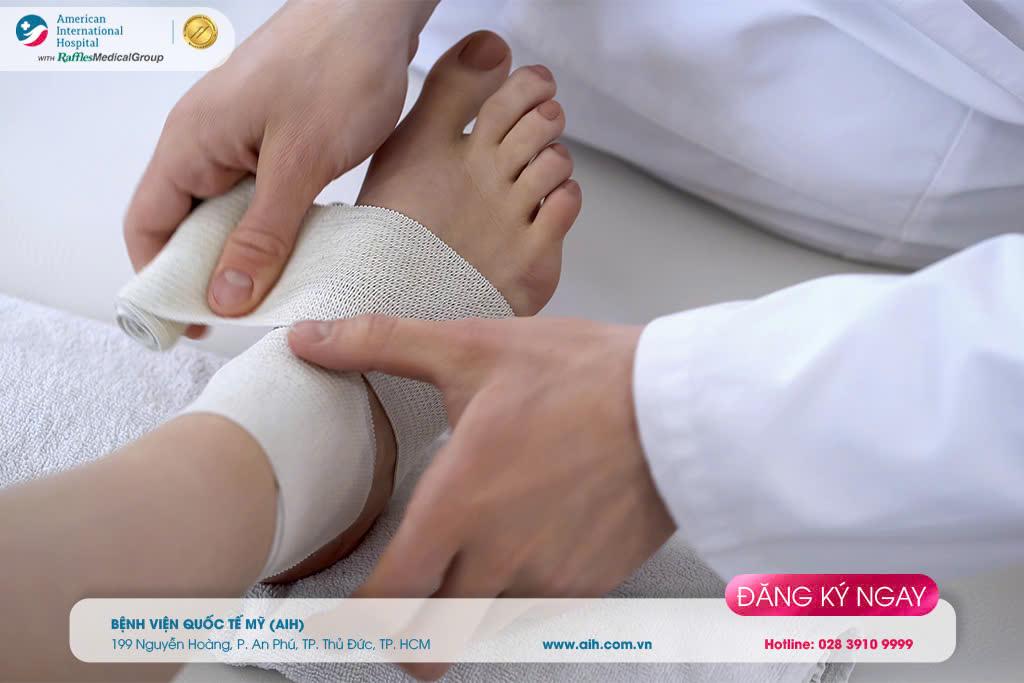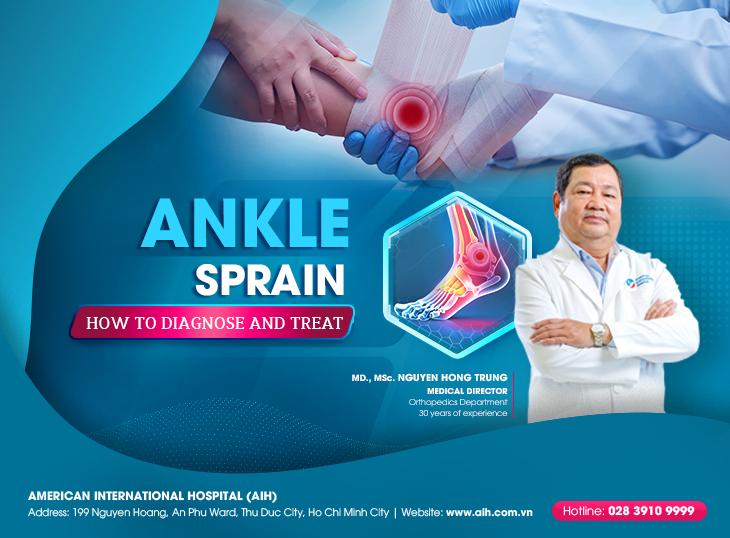Book Now
Date
Select your preferred day for appointment from the below calendar
Specialty
Scroll down the below list to select a specialty
Doctor
Scroll down the below list to select a doctor for your appointment
Time
Select the specific time for appointment from the below schedule
Phone number
Please enter your phone number so that we can give you the best support
Notification
Please fill in the information below
*
*
*
*
*
*
Urgent
ANKLE SPRAIN – UNDERSTANDING AND TREATMENT
An ankle sprain is a soft tissue injury, involving rupture or overstretching of the ligament. It can happen in anyone, especially without caution during physical activities or sports, as the ankle is moving in a repetitive motion. While this condition is not difficult to treat; improper treatment can cause chronic pain, affecting majorly to daily acitivies, mobility and quality of life.
► What is an ankle sprain?
The ankle joint comprises bones of the lower leg and the ankle, connected by a complex system of ligaments. The 3 main groups of ligaments that stabilize ankle bones in their initial positions are:
• Ligaments located on the outer ankle (pinky toe side), inner ankle (big toe side), and between the tibia and fibula.
• Ankle sprain occurs when one of the three ligaments is stretched or ruptured. This usually results from rupture or overstretching of the ligaments or other parts around the ankle.
• This typically happens when the foot twists inward, outward or rotates excessively. If the ankle becomes swollen, warm and experiences a dull ache after an injury, it is highly to be an ankle sprain.

► Who is more likely to experience ankle sprain?
Several groups are at a higher risk of developing an ankle sprain:
• Sport players, especially with indoor sports such as basketball which involves frequent jumping and sudden directional changes while running – key factor that leads to ankle spain.
• People with balance issues, who are prone to falls.
• People who wear high heels or ill-fitting shoes, or inappropriate shoes that are not designed for a specific sport, which can heighten the risk of injury.
• Those with a history of ankle injury, as the ankle joint may remain weak and stiff.
► Causes of ankle sprain
• Incorrect foot landing during running, stepping upstairs or downstairs, or even stepping out of bed the wrong way.
• Stepping on an uneven surface, such as into a pothole.
• Sports injuries: stepping over the opponent’s foot (in football or basketball). Landing from a jump can potentially sprain the ankle due to losing balance.
• Incorrect posture while lifting heavy loads.


► Noticeable signs of ankle sprain
• Pain: depending on the severity of the sprain, pain can range from mild to severe. It might start as a dull pain, then gradually subside. Pain aggravates when the patient touches the ankle area, moves it or walks.
• Swelling, redness and heat: sprain that results in hemorrhage, swelling of the nearby soft tissues can cause the ankle to be swollen several hours after the sprain.
• Bruises: occurs later than pain and swelling.
• Difficulty moving.
► Complications of ankle sprain
Complications of ankle sprain can develop over time if not treated promptly, which can include:
•Joint instability
• Persistent pain
• Osteoarthritis
► Diagnosing ankle sprain
• Clinical examination: The doctor may assess the swollen area around the ankle, move the patient’s foot and ankle to identify which bones are affected, ensure that the nerves and arteries remain intact. Additionally, the doctor will examine the Achilles tendon, which lies longitudinally along the back of the ankle, to evaluate for any potential tearing.
• X-Ray: An X-Ray scan can provide an image of the position and condition of the bones in the ankle area, which helps rule out any bone fractures.
• Ultrasound: Ultrasound is used to evaluate the severity of ligament injuries in the sprained ankle.
• CT scan: An image from a CT scan can show details of the bone and joint at the sprained site.
• MRI (Magnetic Resonance Imaging): An MRI result can visualize the position of the torn ligaments, damaged cartilage, bone fragments or structural changes in the soft tissues around the ankle.


► Treating ankle sprain
Home Remedies
• Resting can help alleviate the pain and pressure on the inflamed tissue.
• Ice compress can reduce swelling and bruising.
• Compression bandaging may help reduce swelling and pain as well as promote quick recovery of tendons and ligaments injuries. The duration for compression may range from 2-3 weeks depending on the severity of the injury. Note: Avoid wrapping too tightly to ensure proper blood circulation.
• Elevating the leg with the sprained ankle by putting it on the chair or wall to keep it straight and raised. This can prevent blood from flowing in to the injury site due to gravity, reducing swelling and edema.


Surgical Treatment
Ankle sprain injuries typically do not require surgery. However, in severe cases where it does not heal naturally, doctors may recommend surgical intervention to repair the damaged ligament. Patients with the following symptoms may be considered for surgery:
• Persistent pain in the foot or ankle
• Frequent recurring ankle sprain
• Ankle pain during running
► Two types of surgeries for ankle ligament repair:
• Endoscopic Surgery: This procedure is performed to repair ligaments.
• Ligament Reconstruction Surgery: The surgeon reconstructs the damaged ligament using a tissue graft taken from other ligaments and/or tendons in the foot and the surrounding ankle region.


► Prevention method for ankle sprain
The best way to prevent an ankle sprain is to maintain muscle strength, balance and flexibility. The following methods might help reduce the risk of an ankle sprain:
• Thoroughly warm up before engaging in exercises and physical activities.
• Improve ankle stability through muscle-strengthening exercises.
• Be cautious when walking, running, working or moving on an uneven surface.
• Wear appropriate shoes suited for specific activities.
• Perform correct movement techniques to avoid sudden injuries from incorrect posture.
--------------------
For checkup and consultation at AIH:
☎ Hotline: (028) 3910 9999
🌏 Website: www.aih.com.vn
📍Address: (Entrance from 199 Nguyen Hoang Street) No.6, Bac Nam 3 Street, An Phu Ward, Thu Duc City, Ho Chi Minh City.
Search
Latest News
Our Doctor











Leave a comment